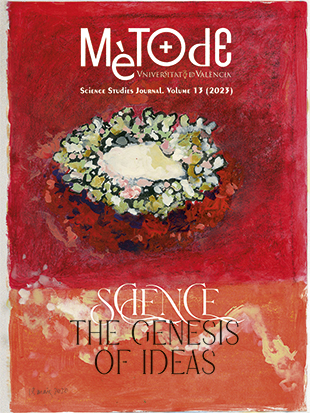Beauty and mate choice: What evolutionary biology can teach us
DOI:
https://doi.org/10.7203/metode.13.24205Keywords:
beauty, mate choice, evolution, evolutionary psychology, sexual selection Abstract
Abstract
We tend to regard beauty as the product of our education, the quintessence of cultural refinement, and we often emphasise the relative nature of beauty. That is why many find it shocking that the perception of beauty, especially human beauty, has a clear biological explanation, one that is largely independent from our education and culture. People are surprised because not only do the characteristics that define beauty originate in biology, but they are also universal and common to all members of our species.
 Downloads
Downloads
 References
References
Bovet, J., & Raymond, M. (2015). Preferred women’s waist-to-hip ratio variation over the last 2,500 years. PLOS ONE, 10(4), e0123284. https://doi.org/10.1371/journal.pone.0123284
Buss, D. (2016). The evolution of desire: Strategies of human mating. Basic Books.
Cloud, J. M., & Perilloux, C. (2014). Bodily attractiveness as a window to women’s fertility and reproductive value. In V. A. Weekes-Shackelford & T. K. Shackelford (Eds.), Evolutionary perspectives on human sexual psychology and behavior (pp. 135–152). Springer. https://doi.org/10.1007/978-1-4939-0314-6_7
Coetzee, V., Greeff, J. M., Stephen, I. D., & Perrett, D. I. (2014). Cross-cultural agreement in facial attractiveness preferences: The role of ethnicity and gender. PLOS ONE, 9(7), e99629. https://doi.org/10.1371/journal.pone.0099629
Cunningham, M. R., Roberts, A. R., Wu, C. H., Barbee, A. P., & Druen, P. B. (1995). “Their ideas of beauty are, on the whole, the same as ours”: Consistency and variability in the cross-cultural perception of female attractiveness. Journal of Personality and Social Psychology, 68(2), 261–279. https://doi.org/10.1037/0022-3514.68.2.261
Darwin, C. (1871). The descent of man and selection in relation to sex. Murray.
Etcoff, N. (1999). Survival of the prettiest: The science of beauty. Anchor Books.
Font, E., & Carazo, P. (2021). False dichotomies and human sexual size dimorphism: A comment of Dunsworth (2020). Evolution and Human Behavior, 42(2), 176–178. https://doi.org/10.1016/j.evolhumbehav.2020.08.003
Grammer, K., Fink, B., Møller, A. P., & Thornhill, R. (2003). Darwinian aesthetics: Sexual selection and the biology of beauty. Biological Reviews, 78(3), 385–407. https://doi.org/10.1017/s1464793102006085
Kenrick, D. T., Keefe, R. C., Bryan, A., Barr, A., & Brown, S. (1995). Age preferences and mate choice among homosexuals and heterosexuals: A case for modular psychological mechanisms. Journal of Personality and Social Psychology, 69(6), 1166–1172. https://doi.org/10.1037/0022-3514.69.6.1166
Langlois, J. H., Kalakanis, L., Rubenstein, A. J., Larson, A., Hallam, M., & Smoot, M. (2000). Maxims or myths of beauty? A meta-analytic and theoretical review. Psychological Bulletin, 126(3), 390–423. https://doi.org/10.1037/0033-2909.126.3.390
Langlois, J. H., Ritter, J. M., Roggman, L. A., & Vaughn, L. S. (1991). Facial diversity and infant preferences for attractive faces. Developmental Psychology, 27(1), 79–84. https://doi.org/10.1037/0012-1649.27.1.79
Miller, G. F. (2000). The mating mind: How sexual choice shaped the evolution of human nature. Vintage.
Muller, M. N., Thompson, M. E., & Wrangham, R. W. (2006). Male chimpanzees prefer mating with old females. Current Biology, 16(22), 2234–2238. https://doi.org/10.1016/j.cub.2006.09.042
Singh D., Dixson B. J., Jessop T. S., Morgan B., & Dixson A. F. (2010). Cross-cultural consensus for waist–hip ratio and women’s attractiveness. Evolution and Human Behavior, 31(3), 176–181. https://doi.org/10.1016/j.evolhumbehav.2009.09.001
Singh, D. (1993). Adaptive significance of female physical attractiveness: Role of waist-to-hip ratio. Journal of Personality and Social Psychology, 65(2), 293–307. https://doi.org/10.1037//0022-3514.65.2.293
Singh, D., & Singh, D. (2011). Shape and significance of feminine beauty: An evolutionary perspective. Sex Roles, 64, 723–731. https://doi.org/10.1007/s11199-011-9938-z
Singh, D., Renn, P., & Singh, A. (2007). Did the perils of abdominal obesity affect the depiction of female beauty in the sixteeth to eighteenth century British literature? Exploring the health and beauty link. Proceedings of the Royal Society of London B, 274(1611), 891–894. https://doi.org/10.1098/rspb.2006.0239
Stewart-Williams, S., & Thomas, A. G. (2013). The ape that thought it was a peacock: Does evolutionary psychology exaggerate human sex differences? Psychological Inquiry, 24(3), 137–168. https://doi.org/10.1080/1047840X.2013.804899
Symons, D. (1995). Beauty is in the adaptations of the beholder: The evolutionary psychology of human female sexual attractiveness. In P. R. Abramson & S. D. Pinkerton (Eds.), Sexual nature, sexual culture (pp. 80–119). The University of Chicago Press.
Trivers, R. L. (1972). Parental investment and sexual selection. In B. Campbell (Ed.), Sexual selection and the descent of man 1871-1971 (pp. 139–179). Aldine Publishing Company.
Downloads
Published
How to Cite
-
Abstract1659
-
PDF661
Issue
Section
License
![]()
All the documents in the OJS platform are open access and property of their respective authors.
Authors publishing in the journal agree to the following terms:
- Authors keep the rights and guarantee Metode Science Studies Journal the right to be the first publication of the document, licensed under a Creative Commons Attribution-NonCommercial-NoDerivatives 4.0 International License that allows others to share the work with an acknowledgement of authorship and publication in the journal.
- Authors are allowed and encouraged to spread their work through electronic means using personal or institutional websites (institutional open archives, personal websites or professional and academic networks profiles) once the text has been published.





